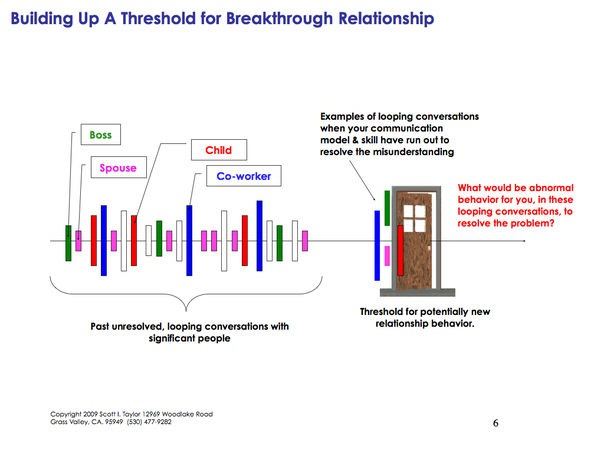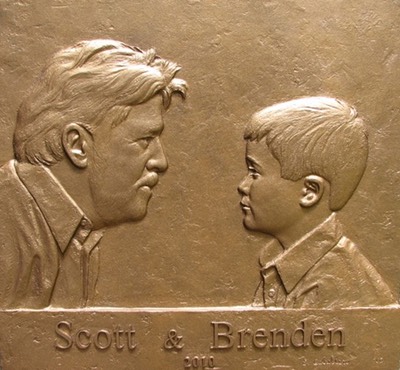We all have a number of specific conversations that we dread. It may be with a spouse, child, family member, neighbor, boss, peer or employee.
We know the conversation is in trouble because of the tone of voice, gestures and words used. We have been down this road before. The results are always predictable & uncomfortable. We have reached a conversation threshold that does not get resolved with continued interaction, regardless of our intentions.
In the following exercise we will identify conversations that start out well, but in a short time predictably deteriorates from bad to worse. Their defining mark is that they leave us with a distinct residue.
Residue is that feeling in our bodies that is like a pressure, an ache or heaviness. It stays with us long after the conversation has ended & acts as a reminder that things did not go as intended.
Residue drains our energy reserves. We, in effect, carry the other person on our backs to the next encounter, again repeating the same unproductive conversation.
Residue most often occurs when we interact with specific people, who behave in a specific way, around a particular topic or concern.
Think of 5 conversations where you are unable to achieve the results you want with a:
Husband, wife, child, in-law, or friend.
Boss, peer, employee, vender, or customer.
Neighbor, clerk, attendant, service person or authority.
Write down each persons name and a short phrase that describes the conversation that seems to have no resolution.
Threshold Image
When acting according to how we feel, there is a sense of being in control & of being right. However, if the conversation deteriorates from bad to worse, continuing the interaction may not give us the result we intended.
The solution is to use behavior that is outside or the opposite of the one that did not work. “Outside of normal behavior” is defined as behavior that is contrary to how we feel, or acting the opposite way from the behavior that is not working. Below are some examples:
Changing Threshold Conversations: Identifying
This diagram shows a time line of past conversations with various people. The colored lines represent conversations about specific topics, concerns or situations that remain unresolved with those people. Conversations where our relationship-communication model runs out of options, our best attempts fail, and fight or flight behavior kicks in.
Solution:
What is being called for is to re-act (respond) in a new, “abnormal” way to threshold conversations.
Re-act in a way that is, for us, “abnormal” behavior.
Reenact in the difficult conversation in order to move from a state of reaction to one of response.
To do this we need healthy, “abnormal for us” behavior. It will be a behavior that is outside our comfort zone; a behavior that we would not normally think to use with that person, in that situation.
As we try this new abnormal behavior, it may bring up feelings of anxiety, vulnerability and risk. These healthy abnormal behaviors are counter to how our hardwiring wants us to feel. However, these are the feelings that we need to learn and trust. These are responsive feelings that address behavior and Core Intentions at the same time.
When using this new, out-of-normal behavior to respond to the other person, start by:
First communicating to their Core Intentions. Remember, they want to communicate, connect and be seen, understood, accepted, chosen and valued.
Use an OREO cookie to speak of a common history together, how each of you has a part in the problem behavior and how you want the conversation to be different in the future. Be verbally specific about how you want the relationship to end.
Changing Threshold Conversations: Solution
When acting out, according to how we reactively feel, there is a sense of being in control and of being right. However, if the conversation deteriorates from bad to worse, continuing the interaction may not give us the result we intended. The solution is to use healthy abnormal behavior that is outside, or the opposite, of the one that did not work. Seems simple doesn’t it?
“Healthy Abnormal Behavior” is defined as behavior that is contrary to how we feel, or acting the opposite way from the behavior that is not working.
In threshold conversations, we can become caught in an unending cycle of being right but not happy. We have reached an impasse at the conversation threshold and wind up in a reactive state. Using” healthy abnormal behavior” we can break up the stalemate and let each person be successful in being seen, understood, accepted, chosen and valued. Below are normal behaviors and their abnormal or out-of-normal equivalents.
For an example, lets say we become defensive when a colleague becomes critical of our work habits. If we use the OREO technique to show our openness (opposite of defensiveness), we could first praise (opposite of criticalness) them for their XXX?
Copyright © 2020 Scott Taylor Consulting All Rights Reserved.
